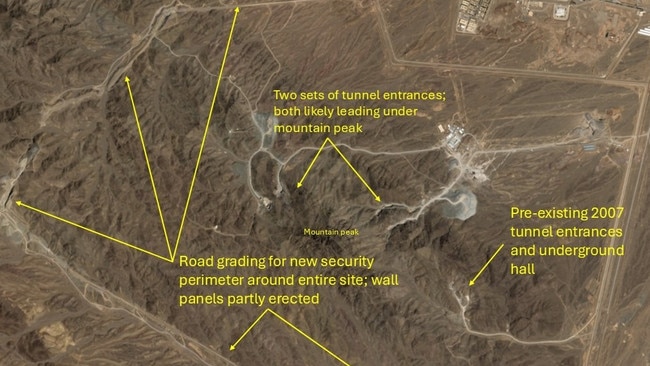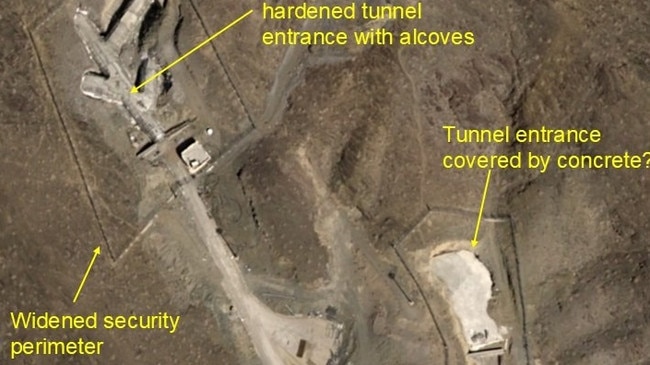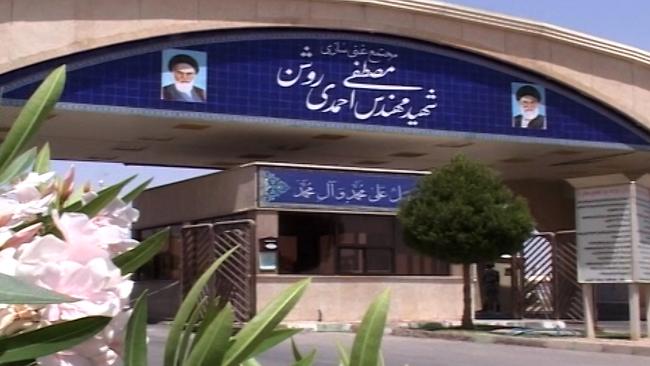Iran tunnels around key nuclear site raises fears of hidden uranium
Iran is urged explain the tunnels around Natanz site amid fears they’re hiding highly enriched uranium or thousands of advanced centrifuges that could take uranium to a level sufficient for a nuclear bomb.

The head of the UN nuclear watchdog agency has called on Iran to explain tunnels built around a major nuclear site amid fears they could be used to hide enriched uranium from inspectors.
As talks continue between the US and Iran over Tehran’s nuclear program, the Institute for Science and International Security, a Washington think tank, released satellite imagery on Wednesday that it said showed a new, deeply buried tunnel alongside an older one around the Natanz site, as well as a new security perimeter.
In a report on the tunnels, David Albright, the institute’s president, said the new security complex suggests the tunnels could be used to store highly enriched uranium, nuclear material that Iran doesn’t report, or “a few thousand” advanced centrifuges that can enrich uranium to a level sufficient for a nuclear bomb in a short time.
“Given that Iran has deployed about 6000 advanced centrifuges at Fordow and the Natanz Fuel Enrichment Plant (FEP) over the last year, all produced outside of International Atomic Energy Agency (IAEA) monitoring, Iran appears capable of secretly deploying a few thousand advanced centrifuges in the new tunnel complex,” Mr Albright wrote.

Mr Albright said in its negotiations with Iran, the United States should make clear that “if Iran were to move, or has already moved enriched uranium stocks, centrifuges, or key centrifuge-related equipment to these underground facilities, this would be detrimental to negotiations”.
Rafael Grossi, director general of the IAEA, said it “cannot be excluded” that the tunnels would store undeclared material.
“I’ve been raising this issue repeatedly, and I will continue to do so,” Mr Grossi told reporters on a visit to Washington.

The IAEA director general, who visited Tehran last week, said all countries need to inform the IAEA of intentions for facilities around nuclear sites but that Iran has a stance “unique in the world” that it does not need to inform the agency ahead of time.
“We’re asking them, what is this for? They are telling us, it’s none of your business,” he said.
He also said Iranian and IAEA experts would meet to follow up on his visit, including on reinstalling cameras on nuclear sites.
Iran suspended IAEA access to certain nuclear facilities in February 2021 as part of its campaign to push the United States to lift sanctions, but agreed to allow cameras to continue surveilling those locations. However Tehran switched off those cameras in 2022, and while the IAEA began reinstalling them at certain facilities in 2023, the concern has remained that when eyes weren’t on them, they were able to construct and hide centrifuges.
“It was agreed that I am sending a technical team to continue our discussions on this very specific kind of things,” Mr Grossi said.
“They are going to be meeting in the next few days in Tehran.”
The warning came as the Trump administration prepared to suggest it would allow Iran to have a civil nuclear program that relies exclusively on imported nuclear fuel.
Secretary of State Marco Rubio told the podcast The Free Press that such a compromise would prevent Tehran from building a nuclear weapon.
“If Iran wants a civil nuclear program, they can have one just like many other countries in the world,” Mr Rubio said. But he added, Tehran would be required to “import enriched material.”
Allowing Iran to have a program solely for civilian purposes is a step back from insisting the country dismantle its nuclear program – a demand Tehran has consistently said it would not accept. But it would still block Iran’s pathway to a bomb, as it would not be allowed to enrich its own uranium.

However if Iran was hiding uranium and centrifuges, such an agreement would do little to constrain Tehran’s nuclear ambitions.
Iran and the United States have held two rounds of talks since Donald Trump called for a diplomatic solution to avoid conflict. A new round of technical talks is expected this weekend.
Mr Grossi said he was optimistic for theoutcome of the talks. “I think there’s a general expectation that this goes well and that the agreement is verified by the IAEA,” he said.
He said that was “more or less the sense of what I’m getting when I’m talking to leaders,” mentioning specifically Chinese Foreign Minister Wang Yi as hopeful for a US-Iran deal.
Although Mr Trump has voiced hope for a new accord with Iran, he has threatened a strike – to be led by Israel – if the talks fail.
Asked about a military option, Mr Grossi said: “I should simply remind that attacks on nuclear facilities is something that could have potentially very, very serious consequences.”
The Trump administration has kept up sanctions despite the diplomacy. On Tuesday, the Treasury Department imposed sanctions on an Iranian shipping network and its purported owner.
Iranian foreign ministry spokesman Esmaeil Baqaei responded that the move was in “clear contradiction with the United States’ demand for dialogue and negotiation and indicates America’s lack of goodwill and seriousness in this regard.”
With AFP



To join the conversation, please log in. Don't have an account? Register
Join the conversation, you are commenting as Logout